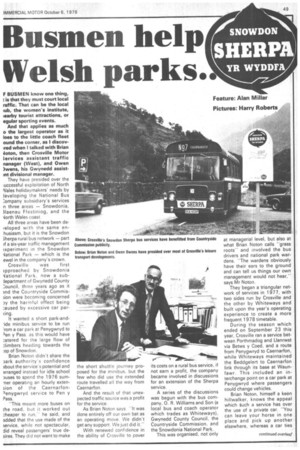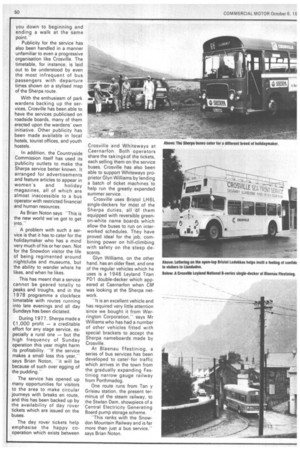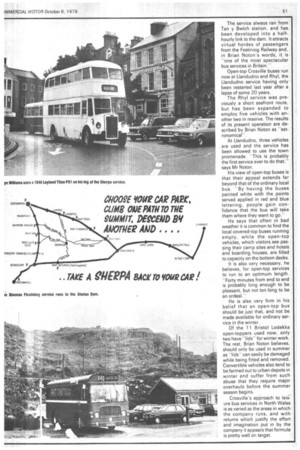Busmen help Welsh parks.
Page 53

Page 54

Page 55

If you've noticed an error in this article please click here to report it so we can fix it.
F BUSMEN know one thing, t is that they must court local raffic. That can be the local oub, the women's institute, iearby tourist attractions, or egular sporting events.
And that applies as much o the largest operator as it loes to the little coach fleet ound the corner, as I discovwed when I talked with Brian doton, then Crosville Motor iervices assistant traffic nanager (West), and Owen )wens, his Gwynedd assistint divisional manager.
They have presided over the mccessful exploitation of North (Vales holidaymakers' needs by leveloping the National Bus :ompany subsidiary's services n three areas — Snowdonia, 3Iaenau Ffestiniog, and the Jorth Wales coast.
All three areas have been dereloped with the same en husiasm, but it is the Snowdon Therpa rural bus network — part af a six-year traffic management 3xperiment in the Snowdon Vational Park — which is the ewel in the company's crown.
Crosville was first 3pproached by Snowdonia slational Park, now a sub lepartment of Gwynedd County :ouncil, three years ago as it
3 n d the Countryside Commis;ion were becoming concerned 3y the harmful effect being ..:aused by excessive car par(ing.
It wanted a short park-and-ide minibus service to be run
:rom a car park at Penygwryd to en y Pass. as this would have • .atered for the large flow of climbers heading towards the :op of Snowdon.
Brian Noton didn't share the Dark authority's confidence about the service's potential and arranged instead for idle school
Duses to spend the 1976 sum-ner operating an hourly exten
sion of the Caernarfon'enygwryd service to Pen y Pass.
"This meant more buses on the road, but it worked out zheaper to run," he said, and added that the use made of the service, while not spectacular, did reveal passengers' true desires. They did not want to make the short shuttle journey proposed for the minibus, but the few who did use the extended route travelled all the way from Caernarfon.
And the result of that unexpected traffic source was a profit for the service.
As Brian Noton says "It was done entirely off our own bat as an operating move. We didn't get any support. We just did it."
With renewed confidence in the ability of Crosville to pover its costs on a rural bus service, if not earn a profit, the company became involved in discussions for an extension of the Sherpa service.
A series of the discussions was begun with the bus cornpany, 0. R. Williams and Son (a local bus and coach operator which trades as Whiteways), Gwynedd County Council, the Countryside Commission, and the Snowdonia National Park. This was organised, not only at managerial level, but also at what Brian Noton calls "grass roots" and involved the bus drivers and national park wardens. "The wardens obviously have their ears to the ground and can tell us things our own management would not hear," says Mr Noton.
They began a triangular network of services in 1977, with two sides run by Crosville and the other by Whiteways and built upon the year's operating experience to create a more frequent 1978 timetable.
During the season which ended on September 23 this year, Crosville ran a service between Porthmadog and Llanrwst via Betws y Coed, and a route from Penygwryd to Caernarfon, while Whiteways maintained the Beddgelert to Caernarfon link through its base at Waunfawr. This included an interchange point on a car park at Penygwryd where passengers could change vehicles.
Brian Noton, himself a keen hillwalker, knows the appeal which Such a service has over the use of a private car. "You can leave your horse in one place and pick up another elsewhere, whereas a car ties you down to beginning and ending a walk at the same point."
Publicity for the service has also been handled in a manner unfamiliar to even a progressive organisation like Crosville. The timetable, for instance, is laid out to be understood by even the most infrequent of bus passengers with departure times shown on a stylised map of the Sherpa route.
With the enthusiasm of park wardens backing up the services, Crosville has been able to have the services publicised on roadside boards, many of them erected upon the wardens' own initiative. Other publicity has been made available in local hotels, tourist offices, and youth hostels.
In addition, the Countryside Commission itself has used its publicity outlets to make the Sherpa service better known. It arranged for advertisements and feature articles to appear in women's an d holiday magazines, all of which are almost inaccessible to a bus operator with restricted financial and human resources.
As Brian Noton says "This is the new world we've got to get into.
A problem with such a service is that it has to cater for the holidaymaker who has a mind very much of his or her own. Not for the Snowdon visitor the life of being regimented around nightclubs and museums, but the ability to wander where he likes, and when he likes.
This has meant that a service cannot be geared totally to peaks and troughs, and in the 1978 programme a clockface timetable with routes running into late evenings and all day Sundays has been dictated.
During 1977, Sherpa made a £1,000 peofit — a creditable effort for any stage service, especially a rural one — but the high frequency of Sunday operation this year might harm its profitability. "If the service makes a small loss this year,'' says Brian Noton, "it will be because of such over egging of the pudding."
The service has opened up many opportunities for visitors to the area to make circular journeys with breaks en route, and this has been backed up by the availability of day rover tickets which are issued on the buses.
The day rover tickets help emphasise the happy cooperation which exists between Crosville and Whiteways at Caernarfon. Both operators share the takings of the tickets, each selling them on the service buses. Crosville has also been able to support Whiteways proprietor Glyn Williams by lending a batch of ticket machines to help run the greatly expanded summer service.
Crosville uses Bristol LH6L single-deckers for most of the Sherpa duties, all of them equipped with reversible greenon-white name boards which allow the buses to run on interworked schedules. They have proved ideal for the job, combining power on hill-climbing with safety on the steep descents.
Glyn Williams, on the other hand, has an older fleet, and one of the regular vehicles which he uses is a 1946 Leyland Titan PD1 double-decker which appeared at Caernarfon when CM was looking at the Sherpa network.
-It is an excellent vehicle and has required very little attention since we bought it from Warrington Corporation," says Mr Williams who has had a number of other vehicles fitted with special brackets to accept the Sherpa nameboards made by Crosville.
At Blaenau Ffestiniog, a series of bus services has been developed to cater for traffic which arrives in the town from the gradually expanding Festiniog narrow gauge railway from Porthmadog.
One route runs from Tan y Grisiau station, the present terminus of the steam railway, to the Stwlan Dam, showpiece of a Central Electricity Generating Board pump storage scheme.
"This ranks with the Snowdon Mountain Railway and is far more than just a bus service," says Brian Noton. The, service always ran from Tan y BwIch station, and has been developed into a half hourly link to the dam. It attracts virtual hordes of passengers from the Festiniog Railway and, in Brian Noton's words, it is "one of the most spectacular bus services in Britain."
Open-top Crosville buses run now at Llandudno and Rhyl, the Llandudno service having only been restarted last year after, a lapse of some 20 years.
The Rhyl service was previously a short seafront route, but has been expanded to employ five vehicles with another two in reserve. The results of its present operation are described by Brian Noton as "astronomical".
At Llandudno, three vehicles are used and the service has been allowed to use the town promenade. "This is probably the first service ever to do that,' ' says Mr Noton.
His.view of open-top buses is that their appeal extends far beyond that of the ordinary local bus. ''By having the buses painted white with the points served applied in red and blue lettering, people gain confidence that the bus will take them where they want to go."
He says that often in bad weather it is common to find the local covered-top buses running empty, while the open-top vehicles, which visitors see pas sing their camp sites and hotels and boarding houses, are filled to capacity on the bottom decks. It is also very necessary, he believes, for open-top services
to run to an optimum length. "Forty minutes from end to end is probably long enough to be pleasant, but not too long to be an ordeal."
He is also very firm in his belief that an open-top bus
should be just that, and not be made available for ordinary service in the winter.
Of the 11 Bristol Lodekka open-toppers used now, only two have "lids" for winter work. The rest, Brian Noton believes, should only be used in summer as "lids" can easily be damaged while being fitted and removed.
Convertible vehicles also tend to be farmed out to urban depots in winter and suffer from such abuse that they require major overhauls before the summer season begins.
Crosville's approach to leisure bus services in North Wales is as varied as the areas in which the company runs, and with returns which justify the effort and imagination put in by the company it appears that formula is pretty well on target,


























































































































































